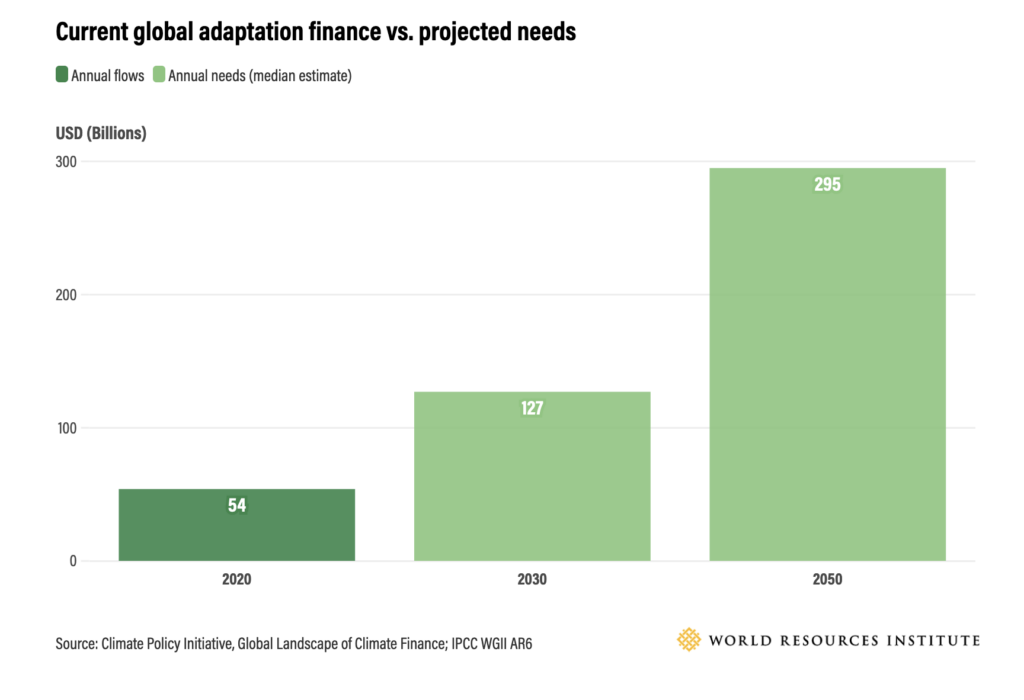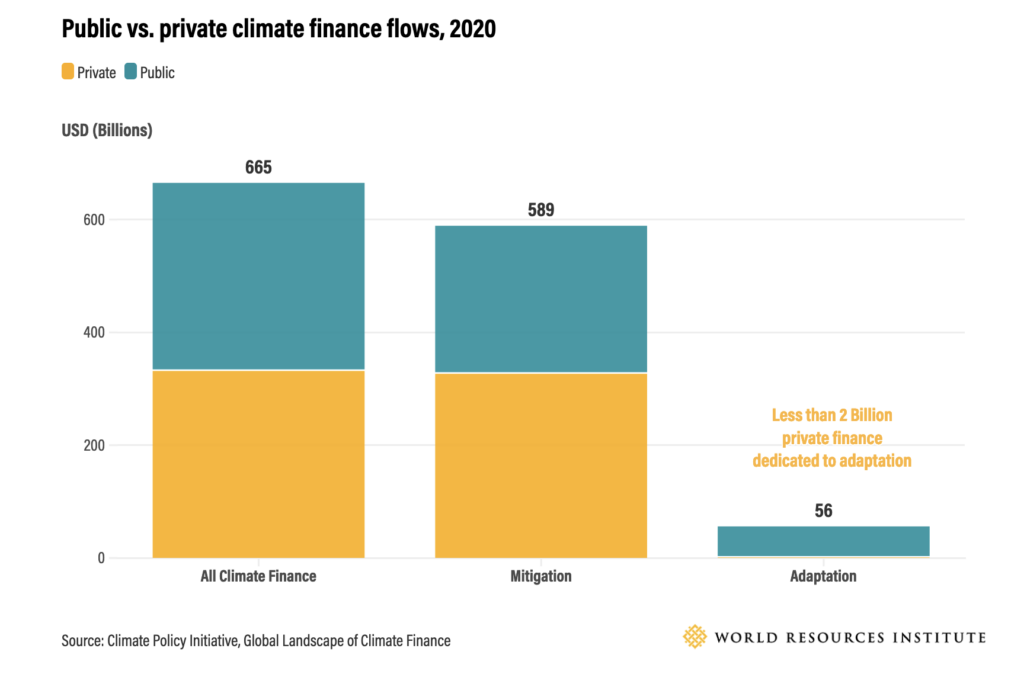Investment in renewable energy reached parity with investment in fossil fuels for the first time in 2022, marking a long-awaited shift toward climate-friendly financial flows. But while reducing emissions is crucial, it is only one aspect of comprehensive climate action.
As the latest report by the Intergovernmental Panel on Climate Change makes clear, the world is rapidly approaching a level of warming that will make it significantly harder to manage drought, heat waves, rising sea levels and other climate-related disasters. Along with scaling efforts to curb emissions, therefore, we must invest substantial resources in building climate resilience and adapting to the changes already underway.
But increasing private sector finance for climate adaptation presents unique challenges. While renewable energy is a promising sector with revenue models well understood by investors, the same cannot easily be said of adaptation measures. Few investors are experienced with adaptation finance, and even fewer are experts at it. This has led to uncertainty about whether the private sector can — or should — fund adaptation on a larger scale.
Still, under specific circumstances, private sector involvement in climate adaptation is possible. Indeed, a compelling case is emerging that the private sector can play an important role in helping fill the adaptation finance gap and making vulnerable communities more resilient to the worst impacts of climate change. Here’s what to know.
Current adaptation finance falls short of the world’s needs
Adaptation finance refers to financial resources aimed at helping communities, companies, countries, and regions adapt to the impacts of climate change. Examples include financing the relocation of an infrastructure project away from areas with rising sea levels, supplying drought-resistant seeds for farming, or building a dam with a larger retention basin to account for increasingly variable rainfall.
Recent climate-driven disasters such as catastrophic floods in Pakistan, Nigeria and Chad, and the prolonged drought and famine in the Horn of Africa, highlight the urgent need for investment in adaptation. Developing countries require an estimated $160-$340 billion per year by 2030 to adapt to increasing climate impacts; this amount is projected to increase to $315-$565 billion by 2050. Right now, however, less than $50 billion — or just 10% of all climate finance — is allocated to adaptation. As emphasized at COP27, the amount of adaptation finance to developing countries needs to increase by 5 to 10 times.
DISCOVER THE SHARM EL SHEIKH ADAPTATION AGENDA
While adaptation finance can come from both public and private capital, the vast majority so far has been public. Corporations and institutional investors provided just $1 billion, or 2%, of tracked adaptation finance in 2019 and 2020, compared to 98% from public sources. (This number accounts only for investment in adaptation projects with public benefits; spending by companies to make their own business models more resilient is not included.)
Measuring private sector climate finance
Tracking climate finance, especially private investment in adaptation, presents significant challenges. Due to the lack of common definitions and tracking mechanisms to capture private expenditures on reducing climate risks, there is limited or incomplete information available regarding the funders, administrators and recipients of adaptation financing. Limited data and knowledge gaps also make it difficult to identify factors that impact private sector investment in adaptation.
Why is private investment in climate adaptation so low?
Some adaptation projects may naturally attract private capital if they operate on a shorter time scale and offer proven cash-flow potential — for example, retrofits to water and sanitation infrastructure. However, many adaptation measures do not fall within this box and will have a more difficult time bringing in private investment.
Private investors may hesitate to invest in adaptation due to several significant barriers, including some that apply to climate projects in general, such as mispricing of natural resources and distortionary subsidies. The three challenges below are especially relevant to adaptation projects.
- Perception that there is no money to be made: Private investors expect to earn competitive risk-adjusted returns from investments. Adaptation projects may be perceived as riskier due to the uncertainty and complexity of climate impacts, and often result in public benefits rather than direct financial returns.
- Information asymmetries and knowledge gaps: Investors may contend with limited access to information on climate impacts, future risks and likely adaptation outcomes. The impact of key approaches such as ecosystem-based adaptation has not been systematically measured; nor have the full range of potential environmental and social benefits been monetized and calculated. This makes it difficult to reliably calculate returns on investment and make informed investing decisions.
- Investment horizon and size of adaptation projects: Most adaptation projects are inherently long-term, taking 10-20 years to implement. It is hard to make the business case for potentially large upfront costs today set against relatively long payback times. In addition, adaptation projects often have relatively small ticket sizes (around $30-$50 million) which may not appeal to traditional investors.
Can the private sector scale up its investment in climate adaptation?
There are very good reasons for businesses and the financial sector to be concerned about climate impacts and adaptation. Private investors face transition risks stemming from shifts in innovation, technology and regulation as well as physical risks from more severe wildfires, water stress, heatwaves and hurricanes. These climate impacts put up to $1 trillion at risk over the next five years for the world’s 215 biggest firms. Businesses are also increasingly under pressure to deliver on ESG expectations.
Given these growing environmental, social and economic risks, private actors may view investment in adaptation not only as a sound financial opportunity, but also an investment in their own long-term stability.
Of course, private capital is not the solution in all situations. Adaptation — particularly in the most vulnerable, low-income regions — often brings public benefits rather than opportunities for private financial return. Likewise, over-emphasizing the potential role of private investment could result in funds being directed to countries with stronger private capital markets, such as emerging and developed economies, rather than to the most vulnerable countries and communities with the greatest need for support. While most people recognize the need for increased adaptation finance, including from the private sector, these constraints mean that many adaptation investments will have to be covered by public funds.
At the same time, there are not enough public resources available to meet the full extent of adaptation needs — whereas private finance, barely tapped so far, may be able to play a much more significant role.
Ways to involve private capital in adaptation finance
Private investors may finance adaptation-related projects on fully commercial terms if they are confident about risk-adjusted returns, such as a venture capital firm investing in start-ups that provide climate risk assessments. However, the uncertain financial value of many adaptation measures — such as protecting coral reefs to support coastal communities whose livelihoods depend on them — means private actors may need additional encouragement to finance these kinds of initiatives.
One way to address this challenge is through the use of public financial resources to de-risk investment opportunities for private investors. One such technique involves “blended finance,” which improves the risk-return characteristics of an investment by pooling capital with different financial and non-financial return expectations within an investment structure. Such an approach can help alleviate concerns about financial uncertainty and knowledge gaps, thereby mobilizing private capital which would not otherwise be available.

Here are a few examples that demonstrate how blended finance can support adaptation initiatives in practice:
Guarantees and co-financing
Public institutions typically finance public infrastructure critical for building resilience to climate impacts, such as water treatment facilities or seawalls. State-owned infrastructure banks, multilateral development banks and export credit agencies play vital roles in financing such projects. However, guarantees, co-financing or other methods of risk reduction can help attract private capital to adaptation solutions.
The Multilateral Investment Guarantee Agency (MIGA), for example, provides guarantees covering country and contract risks to encourage investment in developing countries. In Jordan, MIGA’s guarantee of $13.1 million protected equity investments by private investors, covering them for a period of up to 20 years against the risk of breach of contract. This allowed private investors to finance the expansion of an existing water treatment plant to account for more frequent and intense storms and drought, sea-level rise, saltwater intrusion and the needs of a growing population.
Risk-tolerant capital structures
Risk-tolerant capital is another tool for mobilizing private investment in adaptation. One example is the Global Fund for Coral Reefs, which provides growth equity to the “blue economy,” protecting coral reefs and investing in the activities and economies that depend on them. In this structure, the Green Climate Fund (GCF) agreed to assume the initial losses in an investment to encourage the participation of others who may not have otherwise joined. GCF’s first-loss equity of $125 million is expected to mobilize three times this amount from private and institutional investors, for a total investment of $500 million.
Another example comes from Lightsmith Climate Resilience, a private equity fund that focuses on climate adaptation and resilience and invests in growth-stage technology companies seeking to address the impacts of climate change. The fund uses donor capital to create a risk-absorbing junior layer, which carries a higher potential for loss and helps reduce the level of risk for subsequent investors. Through this approach, Lightsmith aims to attract an estimated $3.30 of direct commercial investment for every dollar contributed by public financial institutions. In 2022, the final closing of the fund reached $186 million in total contributions from both the public and private sectors. The fund has already invested in three growth-stage firms: a U.S.-based water tech company that provides renewable drinking water systems; an Indian food company that uses tech-based supply chain approaches to reduce food waste and improve farm output; and a Brazilian company that provides AI-based solutions for climate-resilient agriculture.
Strategic partnerships can spark a virtuous cycle for adaptation finance
Beyond raising additional capital for climate adaptation, partnerships between the public and private sectors can offer significant non-financial benefits as well.
First, such arrangements can help ensure that private-sector adaptation investments generate the intended climate impact. Funding from public financial institutions means the investment must meet their criteria — such as governance and sustainability standards — along with climate risk screening, environmental and social safeguards, and monitoring and evaluation requirements. Second, these partnerships can help narrow the knowledge and unfamiliarity gap for private investors, since development finance institutions and donor countries have decades of experience and expertise working directly with developing country governments and understand their markets.
On the other side, private investment brings not only additional capital, but also entrepreneurship, efficiency and innovation. This can spark a virtuous cycle by building investor confidence in new opportunities and approaches. These collected benefits help lower the existing barriers to further private investment in adaptation.
With supportive financial structures in place, the private sector can scale up investment in climate change adaptation — and in fact could play an essential role in closing the substantial adaptation finance gap. This will require a carefully designed and balanced approach that leverages both public and private financing and resources. Over time, such partnerships can help facilitate a broad-based scale-up of adaptation investments to the benefit of communities and investors alike.
This article was produced in collaboration with the Republic of Korea’s National Institute of Green Technology and was first published by the WRI.



